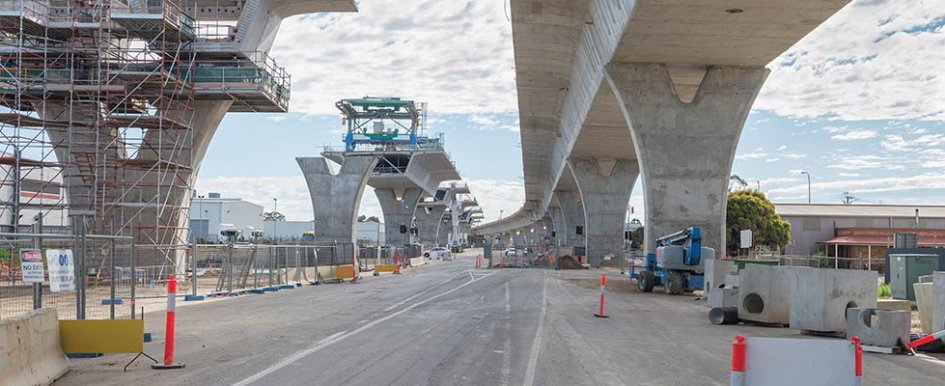
Construction firms in the U.S. are facing a myriad of battles when it comes to keeping projects on track. Some are related to economic woes beyond their control, but much of what holds projects back are the strategies being used to manage the fundamentals, such as inventory flow.
The traditional approach on construction sites is to order materials early and have them delivered and ready when the project begins. It’s a simple strategy, but one that lacks the efficiency needed to keep projects on track, especially in current times.
In 2020, McKinsey & Company listed just-in-time logistics (JIT) as part of the “next normal” in construction. It offers an alternative method for inventory management, underpinned by the belief that reducing waste and expenses starts with delivery planning. Keep reading to learn why this strategy is so important for heavy civil construction — and how to use it to keep your projects on track.
Why Just-in-Time Logistics Matter
Inventory management is a critical part of running any construction project. Whether it’s a road, a pipeline or another civil asset, teams must manage large volumes of materials moving in and out of the jobsite. In JIT logistics, materials are delivered only when they’re needed. For example, concrete arrives the day before a pour rather than a week in advance.
The orders themselves, however, are planned well in advance, and deliveries are scheduled according to the project timeline. This matters for heavy civil construction because it reduces inventory holdings and associated expenses while streamlining overall inventory and delivery management. This disciplined planning also helps prevent supply chain disruption by aligning supplier capacity with real project needs.
Uncovering the Cost of Material Overstock & Delivery Delays
A key competency of any effective project manager is the ability to control a jobsite and its inventory. Their project management strategy will impact whether a project exceeds the initial budget or schedule.
For example, in an attempt to avoid the pitfalls of understocking or delayed material deliveries, many project managers will turn to bulk ordering as a buffer. The idea makes sense: Gather up all the materials needed in advance of a project, plus some extra as backup, and protect the workflow from the risk of a supply chain disruption.
Considering that delivery delays can halt workflows, complicate timelines and cause various other problems, it’s understandable why so many respond to these risks with material overstocking. The problem, as the Lean Construction Institute explains, is that bulk orders and overstocking bring many of their own risks and financial issues, such as the following:
- Tying up capital unnecessarily
- Incurring added storage and maintenance costs for all stock that must be housed
- Materials getting damaged or degraded if stored for too long.
- Site congestion caused by disorganized stock that teams are struggling to store
- Added pressure on inventory management. All that stock needs to be monitored to avoid theft or misplacement
- Creating added waste because the stock was damaged or never used in a project
Bulk orders might seem like the most cost-effective approach, but relying solely on them can mean missing out on last-minute price drops.
How Precise Deliveries Cut Downtime & Protect Budgets
Chaos can quickly ensue on a project where bulk orders and overstocking have taken over. Roads are blocked with excess materials, labor is wasted on inventory management and no one can find the very specific item needed to finish a task because it was ordered so early in the project that it’s now lost.
Precise deliveries cut through all of this and help project managers build more stable budgets and jobsites. Here’s how:
- There is less time wasted searching for materials or waiting for deliveries. A JIT delivery will happen just days before use so that everything is ready and easy to access for planned tasks.
- Less overcrowding also reduces safety issues and overall risk.
- Tighter deliveries support tighter schedules. They help keep labor and tasks on track.
From a budgeting perspective, JIT cuts down on storage costs, theft and damage risks, as well as the expense of last-minute orders. It also assists with cash flow, as it ensures that funds aren’t stuck in unused inventory.
Syncing JIT Logistics With Your Project Timeline & Cost Targets
The challenge with JIT is that it requires teams to integrate logistics into project planning right from the start. That’s what ensures the biggest efficiency gains and expense reductions. Smarter technology is the key to making this happen.
Automated systems can be used to track tasks and finalize deliveries based on set triggers and construction phases. For example, as soon as a permit approval comes in, a material delivery is scheduled.
Procurement also needs to be synced with cost targets. A good inventory management system can track cost changes with vendors, predict fluctuations and help teams get the best possible price. It can also be used to align orders with cash flow and ensure that materials only arrive when money is there to pay for them.
Together, the overall impact of the synchronization that JIT demands is more streamlined sites that aren’t bogged down by the hassle of excess inventory or delayed deliveries. Budgets, schedules and deliveries are all considered together, which prevents any one area from blocking the other.
Driving Civil Projects Forward With Smarter Logistics
JIT cuts back on the seemingly small inefficiencies of a jobsite so that civil projects can operate with leaner budgets and schedules. It’s a smarter logistics approach for this, but it also involves the use of smart technology to track and automate the procurement and delivery process. This is a key part of how JIT drives civil projects toward the future. It forces teams to embrace technology, take scheduling seriously and see logistics as an integral part of a project. In doing so, JIT helps unlock an underutilized aspect of construction as a strength rather than a weakness.
